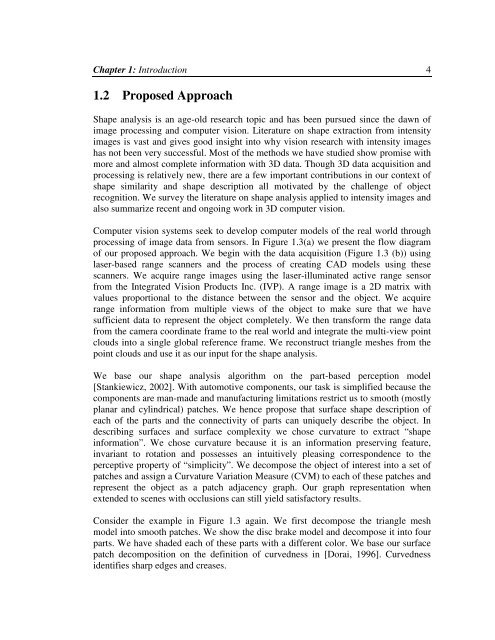To the Graduate Council: I am submitting herewith a thesis written by ...
To the Graduate Council: I am submitting herewith a thesis written by ...
To the Graduate Council: I am submitting herewith a thesis written by ...
You also want an ePaper? Increase the reach of your titles
YUMPU automatically turns print PDFs into web optimized ePapers that Google loves.
Chapter 1: Introduction 41.2 Proposed ApproachShape analysis is an age-old research topic and has been pursued since <strong>the</strong> dawn ofimage processing and computer vision. Literature on shape extraction from intensityimages is vast and gives good insight into why vision research with intensity imageshas not been very successful. Most of <strong>the</strong> methods we have studied show promise withmore and almost complete information with 3D data. Though 3D data acquisition andprocessing is relatively new, <strong>the</strong>re are a few important contributions in our context ofshape similarity and shape description all motivated <strong>by</strong> <strong>the</strong> challenge of objectrecognition. We survey <strong>the</strong> literature on shape analysis applied to intensity images andalso summarize recent and ongoing work in 3D computer vision.Computer vision systems seek to develop computer models of <strong>the</strong> real world throughprocessing of image data from sensors. In Figure 1.3(a) we present <strong>the</strong> flow diagr<strong>am</strong>of our proposed approach. We begin with <strong>the</strong> data acquisition (Figure 1.3 (b)) usinglaser-based range scanners and <strong>the</strong> process of creating CAD models using <strong>the</strong>sescanners. We acquire range images using <strong>the</strong> laser-illuminated active range sensorfrom <strong>the</strong> Integrated Vision Products Inc. (IVP). A range image is a 2D matrix withvalues proportional to <strong>the</strong> distance between <strong>the</strong> sensor and <strong>the</strong> object. We acquirerange information from multiple views of <strong>the</strong> object to make sure that we havesufficient data to represent <strong>the</strong> object completely. We <strong>the</strong>n transform <strong>the</strong> range datafrom <strong>the</strong> c<strong>am</strong>era coordinate fr<strong>am</strong>e to <strong>the</strong> real world and integrate <strong>the</strong> multi-view pointclouds into a single global reference fr<strong>am</strong>e. We reconstruct triangle meshes from <strong>the</strong>point clouds and use it as our input for <strong>the</strong> shape analysis.We base our shape analysis algorithm on <strong>the</strong> part-based perception model[Stankiewicz, 2002]. With automotive components, our task is simplified because <strong>the</strong>components are man-made and manufacturing limitations restrict us to smooth (mostlyplanar and cylindrical) patches. We hence propose that surface shape description ofeach of <strong>the</strong> parts and <strong>the</strong> connectivity of parts can uniquely describe <strong>the</strong> object. Indescribing surfaces and surface complexity we chose curvature to extract “shapeinformation”. We chose curvature because it is an information preserving feature,invariant to rotation and possesses an intuitively pleasing correspondence to <strong>the</strong>perceptive property of “simplicity”. We decompose <strong>the</strong> object of interest into a set ofpatches and assign a Curvature Variation Measure (CVM) to each of <strong>the</strong>se patches andrepresent <strong>the</strong> object as a patch adjacency graph. Our graph representation whenextended to scenes with occlusions can still yield satisfactory results.Consider <strong>the</strong> ex<strong>am</strong>ple in Figure 1.3 again. We first decompose <strong>the</strong> triangle meshmodel into smooth patches. We show <strong>the</strong> disc brake model and decompose it into fourparts. We have shaded each of <strong>the</strong>se parts with a different color. We base our surfacepatch decomposition on <strong>the</strong> definition of curvedness in [Dorai, 1996]. Curvednessidentifies sharp edges and creases.
















